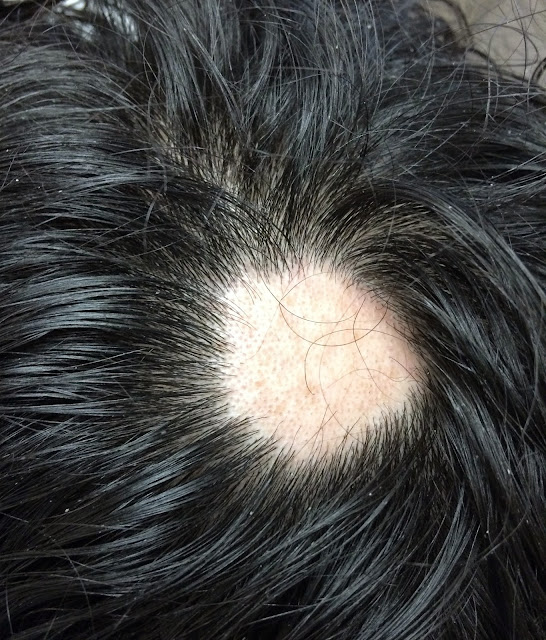Alopecia
Areata (pronounced al-oh-PEE-shah are-ee-AH-tah) is a form of hair loss seen
fairly commonly in the dermatology specialty clinic. It usually results in
circular smooth patches of hair loss, occurring in any age group (more likely
to present in childhood or young adulthood). The hair loss is usually not
associated with any symptoms but sometimes it can be associated with burning or
itching. Although the classic or “textbook” example of alopecia areata involves
one or more circular patches of hair loss, some patiets have a more generalized or diffuse presentation.
An
autoimmune condition is one in which your own body's immune defenses mistakenly
attack your normal “self” tissues. When functioning properly, your immune
system comprised of cells, such as, T cells and B cells circulates in your
vascular system and in your tissues, constantly sifting through, looking for foreign invaders. When
your immune system recognizes foreign invaders, such as viruses and bacteria,
it begins an attack. In alopecia areata, the immune system mistakenly attacks
the hair follicle as if it were a “foreign invader” resulting in hair loss.
Alopecia areata is not a permanent form of hair loss because it does not scar the hair follicles. Regrowth may occur when either topical or injected corticosteroids are used to reduce the localized immune attack on the hair follicles. Sometimes even in the absence of treatment, the immune system may spontaneously regulate itself and turn off the attack on the hair follicles, allowing hair to regrow. I often remind patients that alopecia areata does not imply a “weak” immune system, rather it is a specific little “glitch” in one small set of immune cells. Thus, for the most part, having alopecia areata does not mean that there are necessarily other things wrong with the patient. In fact, it usually occurs by itself in otherwise healthy people. However, sometimes alopecia areata may be found in individuals with other autoimmune conditions like, autoimmune thyroid disease or vitiligo. If the patient with alopecia areata has symptoms like, fatigue, depression or weight gain, etc., the physician will likely check a TSH level (thyroid stimulating hormone) to rule out thyroid disease.
Alopecia areata is not a permanent form of hair loss because it does not scar the hair follicles. Regrowth may occur when either topical or injected corticosteroids are used to reduce the localized immune attack on the hair follicles. Sometimes even in the absence of treatment, the immune system may spontaneously regulate itself and turn off the attack on the hair follicles, allowing hair to regrow. I often remind patients that alopecia areata does not imply a “weak” immune system, rather it is a specific little “glitch” in one small set of immune cells. Thus, for the most part, having alopecia areata does not mean that there are necessarily other things wrong with the patient. In fact, it usually occurs by itself in otherwise healthy people. However, sometimes alopecia areata may be found in individuals with other autoimmune conditions like, autoimmune thyroid disease or vitiligo. If the patient with alopecia areata has symptoms like, fatigue, depression or weight gain, etc., the physician will likely check a TSH level (thyroid stimulating hormone) to rule out thyroid disease.
Alopecia
areata most commonly affects the scalp but may affect any hair-bearing site
such as the eyebrows, beard area, arm-pits and groin. In rare cases, some
patients will lose all of their scalp hair, called alopecia totalis. In even
more extreme and uncommon cases, patients will lose all their body hair called,
alopecia universalis. It must be noted however, the vast majority of patients
do not progress to this extent and most will just have a few small patches, which
grow back in time. Hair may grow back in one place and hair loss may occur in
another. Even when it seems to clear up, it may come back later in life. Increased
stress is a well-known “trigger” for alopecia areata in a genetically
susceptible individual. To be clear, stress does not cause alopecia areata but stress may alter the immune activity of a
genetically predisposed individual and initiate its onset or provoke a flair.
Notice hair regrowth with injections of corticosteroids
Follow David Robles, MD, PhD




Comments
Post a Comment